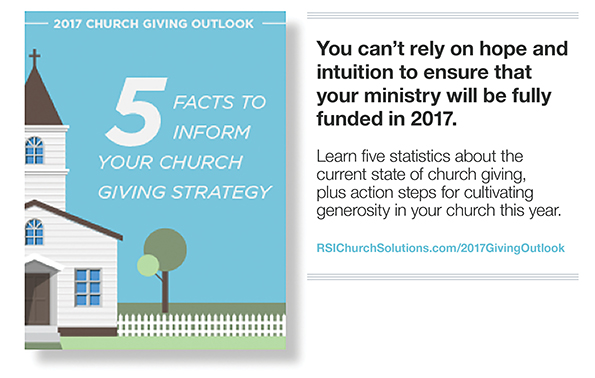
5 mindsets to transform your ministry funding strategy
By Joel Mikell & Curt Swindoll
![]() The challenges the local church faces today are markedly different compared to those of a decade or two ago. Gone are the days of significant numbers of church members attending on Sunday mornings, evenings, and Wednesday nights. Tithing is no longer the norm. And many church members are dividing their donations between the local church and a number of nonprofits and causes.
The challenges the local church faces today are markedly different compared to those of a decade or two ago. Gone are the days of significant numbers of church members attending on Sunday mornings, evenings, and Wednesday nights. Tithing is no longer the norm. And many church members are dividing their donations between the local church and a number of nonprofits and causes.
What’s more, advances in technology, the changing expectations of church members, and the way people engage with their church, continue to evolve; the church increasingly has to compete for attention. These barriers confront almost every church, no matter the size, denominational affiliation, or geographical location.
The good news is, innovative strategies and technologies are emerging that provide church leaders with tools to overcome the obstacles they face. In church, giving has (and always will be) based on the timeless principles of Jesus, but the methods and tools must continue to evolve.
Here are a few proven principles church leaders are embracing to adopt new church giving strategies, improve their efforts to engage people, and fund their vision.
#1: Abandon assumptions that giving this year will follow previous patterns. The 2016 State of the Plate report found that 60 percent of churches experienced flat or declining giving in 2015 compared to 2014. Just because something worked in the past, does not mean it will work in the future.
When times are uncertain, the first thing to go must be our assumptions about how, why, and how frequently people give. The new realities of the changing ministry landscape demand that church leaders have accurate data about who is giving at their church, the channels through which they give, what ministry programs they support, and any changes in giving habits. Without this information, it is difficult to make wise decisions for your church.
Understanding general giving trends is no longer adequate. Effective leaders are well-informed leaders.
#2 Expand giving options. When it comes to the channels through which churches collect contributions, passing an offering plate and placement of donation envelopes in pews continue to be the most widespread and popular methods. However, online and electronic giving might equal or even eclipse those methods in the next decade. The State of the Plate report observed that in the past six years, churches have increasingly adopted digital giving via a diverse array of platforms such as website giving, text-to-give, smartphone apps, and bank EFT autopay. Offering a wider range of giving options allows people to give in ways that feel natural to them.
 #3: Tell more (and more effective) stories of Kingdom impact. The number of non-profit organizations has increased exponentially over the past decade, and more and more church members are dividing their charitable giving between their local church and other nonprofits.
#3: Tell more (and more effective) stories of Kingdom impact. The number of non-profit organizations has increased exponentially over the past decade, and more and more church members are dividing their charitable giving between their local church and other nonprofits.
Additionally, donors across the non-profit spectrum expect higher levels of transparency from the organizations they support, and the church is no exception. Church leaders need to communicate how contributions are being invested for maximum Kingdom impact through compelling stories of changed lives. These messages should not be limited to just the church bulletin or from the pulpit on Sundays, but through the platforms and channels that church members engage with on a daily basis — email, newsletters, the church website, and even personal conversations.
#4: Find ways to engage your financial leaders at a deeper level. One of the realities facing nonprofits and churches alike is a shrinking number of donors and support at the annual giving level, coupled with increases in giving at the leadership level. As a result, financial leaders — those with the capacity and interest in providing a

large gift — will play a growing and crucial role in funding your ministry efforts.
It’s vital that church leaders remember that money doesn’t eliminate the problems in an individual’s life — it magnifies them. Financial leaders need to be appreciated and ministered to just like any other church member.
In addition, develop a vision for their giving that captures and inspires their imagination of what is possible through their support.
#5: Talk to older church members about planned / legacy giving. Churches that have 10+ years of ministry impact, and / or older givers, are likely to have members who would be glad to include their church in their will or estate plan. But, these folks need to be identified and encouraged to consider doing so. Churches that make it a priority to instruct their members about daily financial wisdom would be equally wise to inform them about the importance of having an estate plan that includes giving to their local church.
To overcome the obstacles facing the church today, leaders have a choice between desperate reaction and thoughtful, proactive planning. As a church leader, you must ask yourself: If the current reality of my church is true, what must change today so that God’s vision for our ministry can be achieved?
Often, the answer to that question will require you to step away from the current methods and models of how your ministry is funded. The key is not to fear change and a loss of comfort, but to recognize that Kingdom work more often than not includes a calling to be adaptive and responsive to the changing church giving reality.
More tips for implementing these ideas in your church this year are available in RSI’s free downloadable guide, 2017 Church Giving Outlook [ RSIChurchSolutions.com/2017GivingOutlook ].
Joel Mikell is president of RSI Church Solutions. Follow him on Twitter (@Joel_Mikell), or find him on Facebook.
Curt Swindoll is Executive Vice President of Pursuant Faith, the parent company of RSI. Follow him on Twitter (@CurtSwindoll)


